Jewish History and Historical Fiction Books for Children (Page 4) |
If you wish to purchase any of these books, click on either the title or the book cover to be directed to Amazon.com. As a warning, I have put up pictures of the book covers to give you somewhat an idea of the style of each book (I know, I know. "Don't judge a book by its cover") so the pages may load slowly, depending on the speed of your internet connection.
If this page came up without frames, Click here to see the complete website
For history books for older readers, go to the History Books for Middle School and YA Readers Page
For historical fiction books for older readers, go to the Historical Fiction Books for Middle School and YA Readers Page
Other Pages of Interest:
Children's Jewish History and Historical Fiction Books
(Page 1) |
(Page 2) |
(Page 3) |
(Page 4) |
Easy Reader and Picture Books:
Jewish Children's Books (General) |
Jewish Board Books |
Biblical Stories for Children |
Jewish Holiday Books |
Jewish Family Cookbooks |
Folktales and Talmudic Stories for Children |
Jewish Life Books (Mitzvot, Keeping Kosher, etc.) |
Jewish Life Cycle Books |
Family Haggadahs |
Children's Prayerbooks |
Introductory Hebrew Books |
Jewish History and Historical Fiction Picture Books |
Israel Books
Middle School and YA Books:
Bar Mitzvah Books |
Jewish Fiction |
Historical Fiction |
Torah Study |
Prayer and Jewish Life Books |
Jewish Holidays |
Jewish Biographies |
Jewish History Books |
Holocaust Books for Teens |
Israel Books
Jewish Children's Books |
Bar Mitzvah Books |
Jewish Parenting Books |
Jewish Music for Children |
Jewish Children's Videos |
Jewish Jewelry
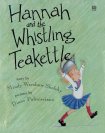
Hannah and the Whistling Teakettle
By Mindy Warshaw Skolsky
Nostalgia and humor are savory ingredients in Skolsky's picture-book tale (adapted from a story in The Whistling Teakettle: And Other Stories About Hannah) starring the heroine of Love from Your Friend, Hannah. Here Hannah visits her grandparents, who own a candy store in the Bronx. Rendered in oil pastels, Palmisciano's (Last Licks: A Spaldeen Story) animated, brightly colored pictures credibly convey the 1930s setting and capture the affectionate bond between two generations. Before boarding the bus, Hannah deliberates over what gift to buy for her practical grandma, who routinely returns presents with the explanation, "Thank you very much, but it's not a necessity." The girl decides on a silver teakettle with a little red bird whistle on the end of its spout. While the woman initially reacts to the gift in her customary fashion, an unusual turn of events makes her change her mind. Skolsky conveys all the warmth between family members that permeate her other Hannah books, and the artwork only underscores their bond. Period details hark back to the days of leisurely afternoons at the soda fountain, while the characters' universal emotions make the illustrations accessible and familiar.
Description from Publishers Weekly
Hannah decides to travel all the way from the country to the Bronx to see her grandparents. It's her first time traveling alone. Even though her grandmother is notorious for refusing presents that are "not a necessity," Hannah brings her a special whistling teakettle. At first, Hannah's grandmother refuses the gift, insisting her old nonwhistling one works fine. However, after the whistling kettle saves Grandma, Hannah, and Grandma's candy store from robbers, Grandma decides to keep it because "Life is a necessity." This sweet, warm-hearted story of family life in 1930s New York is charmingly illustrated by Palmisciano in bright colors, with characters and settings having a fun, comic strip feel to them. Except for details such as hairstyles, clothing, and five-cent phone booths, the story is timeless.
Description from Booklist
It was almost impossible to buy a present for Hannah's grandmother. Whether the gift was a waffle iron or bedroom slippers, Grandma would always say the same thing: "Thank you very much, but it's not a necessity." What could Hannah bring her Bronx-dwelling, soda-fountain-owning grandmother that she wouldn't be forced to return? When she finds a bright silver whistling teakettle with a little red bird at the top, she thinks she's struck gold. After all, her Grandma and Grandpa's kettle is "so old it has bumps."
Hannah can't believe her ears when her grandmother deems the kettle a luxury item. But in an astonishing turn of events in which the piercing "E-e-e-e!" of the teakettle scares off some robbers, Hannah's gift turns out to be very necessary indeed. "'That little bird on the kettle maybe saved our life!' Hannah's grandmother had said. And life she said, was a necessity!" Young readers will love this story of the spirited young Hannah whose thoughtful gift ultimately saves the day. Diane Palmisciano's warm, winning, cartoonish illustrations are the perfect match for this charming, old-fashioned yet timeless story about a close-knit, loving family and what is really important.
Description from Amazon.com
Hannah's grandmother, a loving granny, but a hard case when it comes to accepting gifts, learns the pleasures and benefits of receiving in this story of expectations. Hannah is on a visit to her grandfolks and their soda fountain in the Bronx. She has brought along a whistling teapot as a present for her grandmother, who routinely returns most gifts as frivolous. That appears to be the fate of this one as well when grandma gives it the curse: "It's not a necessity." When Grandma's attention is distracted by a customer out front, Hannah takes the opportunity to put the kettle on the old stove and demonstrate that her grandma no longer need let her tea water boil silently away. Two strange men enter the shop and while one tries to distract Grandma, the other jimmies the pay phone. Next thing you know all chaos breaks loose as a high-pitched whistle cuts the air. Thinking its a police whistle, the robbers skedaddle. Grandma figures she'll keep the kettle after all: " `That little bird on the kettle maybe saved our life!' Hannah's grandmother had said. And life, she said, was a necessity." Palmisciano's (A Spaldeen Story) artwork is filled with little details that fix the time period as a gentler one: Grandmas sagging socks, Grandpas two-toned shoes, and the old-fashioned shop with its 20 cent sundaes. A charming story from a more innocent time.
Description from Kirkus Reviews
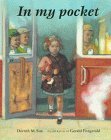
In My Pocket
By Dorrith M. Sim
True to a small child's viewpoint and vocabulary, this moving autobiographical
picture book personalizes the story of the Kindertransport, the organized
rescue operation that took 10,000 Jewish children from Nazi Europe to
Britain. The words are simple. The terse details make you know what it is
like to be sent away like that. Fitzgerald's strong double-page-spread
paintings show the drama of the small girl's leave-taking from her parents in
the lowering Hamburg train station, her journey with strangers by train to
Holland and by boat to Britain, and her meeting with her adoptive parents.
Sepia prints of her visa and certificate of identity are quiet reminders of the
refugee experience. She knows no English; all she can say is, "I have a
handkerchief in my pocket." Whenever she learns a new word, she puts it
in the same sentence: "I have a house in my pocket." The story ends with her
settling in Scotland, where she keeps her parents' letter in her pocket until
there is no more war. Teachers will want to use this with Olga Drucker's
novel Kindertransport (1992), which gives the historical context.
Description from Booklist
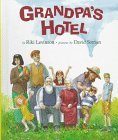
Grandpa's Hotel
By Riki Levinson
Seemingly set in the Catskills during the 1940s or early 1950s, this
remembrance describes the fun a young girl and her extensive family
have at her grandparents' hotel. The young narrator and her 13 cousins
play softball and croquet, eat Grandma's cooking, and wait for three
more cousins to be born. Uncle Herbie, who's in charge of the finances,
thinks that the profits are being eaten up (literally) by too much
family, but Grandpa won't hear of it--there's nothing sweeter than
children. From the grandfather's yarmulke, it's clear that this is an
Orthodox Jewish family, but there's nothing in the text to reflect
that. More of a mood piece than an actual story, this blankets itself
in the warmth of family. Affection and devotion are also manifest in
the watercolor art that re-creates the hubbub that comes when so many
family members gather in one place.
Description from Booklist
The family in the book owns a hotel in the Catskills (probably) and the time appears to be in the 1940s. Grandpa still wears a long white beard and a kippah. While the guests use the hotel, the family crowds into its own small bungalow and has a marvelous time, putting on shows in the casino, scaring the chickens and collecting their eggs, eating, and just having fun. This high-spirited family's good times, made so immediate by Ritz's ebullient watercolors, bring to this reader wistful thoughts of what might have been.
Description from Jewish Book World

Marven of the Great North Woods
In her picture book, the author tells a true story. Sent to
the Great North Woods of Minnesota to protect him
from the 1918-19 influenza epidemic, young Marven
Lasky was given the job of bookkeeping for a logging
camp. The woods were an alien world to this homesick
Jewish city child-loggers, huge trees, bears, no Kosher
food-but with the help of the burly Jean Louis, he began
to feel less alone. Kevin Hawkes' beautiful illustrations
bring the atmosphere of the frozen North Woods to life.
Highly recommended.
Description from Children's Literature

The Legend of Freedom Hill
By Linda Jacobs Altman
Best friends Rosabel and Sophia are outsiders in gold rush California. Rosabel has
freedom papers, but she's the daughter of a runaway slave; Sophia belongs to the only
Jewish family in town. When a slave catcher seizes Rosabel's mother, "Miz Violet," the
two resourceful girls pan for gold, finally discover it in a cave, and use their claim
to buy the freedom of Miz Violet and four other slaves. The informal tone and colloquial
language establish a distinctive storyteller's voice. Cultural and historical facts are
smoothly integrated into the story, but the focus is squarely on the friendship. Dappled
watercolor illustrations provide interesting period details. Dramatic postures and vivid
facial expressions reflect and embellish the narrative but occasionally have a
contemporary look. Children will identify with the spunky, resourceful girls and enjoy
the expeditious resolution.
Description from Booklist
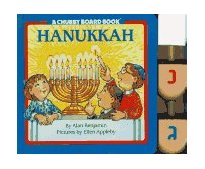
Hanukkah: A Chubby Board Book (Dreidels Included)
By Alan Benjamin
The perfect way to introduce preschoolers to the Festival of Lights, this irresistible package comes with a chubby board book about Hanukkah and two wooden dreidels. The brightly illustrated book describes the many ways Hanukkah is celebrated.
Description from Publisher
This glowing picture book focuses on one family's celebration of Hanukkah. It's the eighth and final night of the holiday and Mama, Papa and Grandma Rose are lighting the menorah, while the children--Nora, Dan, Ruthie, Sam and baby Moe--begin their own preparations for the family celebration. Nora and Dan make latkes, Ruthie makes decorations, Sam makes clay dreidels and tries to teach baby Moe how to say "Hanukkah." The festive family meal is followed by songs, dances and gifts. Finally, as the evening ends and the candles burn low, Moe giggles "Hanuk-kah!" Schotter's somewhat bland text may confuse children with its odd blend of poetry and prose, but Hafner's watercolors of the cozy house filled with the warmth of love and family beautifully evoke this special celebration's pleasures. A one-page "Story of Hanukkah" and a glossary of Hanukkah words are included.
Description from Publishers Weekly
A Jewish family celebrates a happy Hanukkah in the 1950s. Nora leads her four siblings off to make gifts and latkes, spin the dreydel, and they all play until supper. After dinner, the children open presents and enjoy an extended family hug. Hafner's cartoon-lined figures are softened to good effect with watercolor and colored pencil, and the nighttime setting of the story is warm with candlelight and family delight. A final note gives a short explanation of the holiday.
Description from School Library Journal
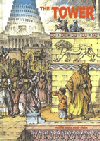
The Tower
By Lene Mayer-Skumanz
The story of Azarya, who was exiled with the Jewish people by King Nevuchadnezer to Babylon. Includes a brief Biblical review of the history of the Jewish people and describes the miraculous escapes of Azarya, Daniel, Hananya and Mishael, the heroes of the Book of Daniel.
Description from Publisher
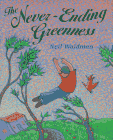
The Never-Ending Greenness
An old man recalls his childhood in the tree-lined city of Vilna,
where his family escapes from the ghetto and is protected by the
forests surrounding the town. Later, following immigration to
Israel, the boy helps plant trees in his new desert homeland so
that the country can once again become a sea of never-ending
greenness. Although the story focuses on the efforts of one family,
its actions reflect a national effort to reforest Israel and correlate
with contemporary celebrations of Tu b'Shvat, the Jewish New
Year of the Trees. Waldman's colorful acrylic paintings, rendered
in an impressionistic style, are best viewed from a story-hour
distance. Liberal use of greens, blues, and pinks creates a hopeful
atmosphere, in keeping with the tone of the story. A perfect choice
for Tu b'Shvat story hours, this will also be useful for
primary ecology units.
Description from Booklist

A Knock at the Door
Books written by children, for children! Choose from the best original stories
selected from among thousands of second- through sixth-grade entries in
Raintree/Steck-Vaughn's annual contest. Professional, full-color artwork
illustrates each young author's work.
The Schmidts welcome the scared, starving stranger to their farm and allow
her to work for food and shelter. Her identity remains a secret, however,
until the day a Nazi soldier knocks on the door. Based on the experiences
of the author's grandmother.
Description from Publisher
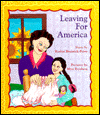
Leaving for America
A tender portrayal of life in a Russian Jewish community as seen through the
eyes of a seven-year-old girl who is leaving with her mother to start a new
life in America.
Description from Publisher
The author recalls her final days spent in Wysokie, Russia, before emigrating
to America with her mother in 1929 at the age of seven. She remembers playing
with her cousin, the many suggestions for success given by well-meaning relatives,
and the tearful advice from her grandfather to remain true to her own identity.
Humorous details (the two wooden rolling pins that crossed the Atlantic in the
family steamer trunk convinced several inspectors that Mrs. Bresnick intended to
beat her husband in America) help to temper the generally reflective mood of this
piece and add to the memoir's child appeal. Reisberg's brightly colored mixed-media
illustrations complement the tone of the story, and the integration of several old
family photos into the paintings works effectively.
Description from Booklist

Ike and Mama and the Once-A-Year Suit
By Carol Snyder
It's the early 1900s, that time of the year again, time
for the boys to get new suits, some for Passover,
some for Easter. Ike's mother is the expert on how
to get the most for their once-a-year suit. Mama, the
acknowledged "best bargainer" in the Bronx, takes
her ecumenical group of fourteen neighborhood
boys on a shopping adventure.
Description from Publisher

Star of Fear, Star of Hope
By Johanna Hoestlandt
This extraordinarily moving picture book, originally published in France
and set in the north of France during World War II, has spare prose
and appropriately stark illustrations. An elderly woman recalls an incident
in her childhood that she would give anything to undo. Her Jewish friend
Lydia is visiting, and, in the middle of the night, a frightened Jewish
woman seeking refuge awakens them by pounding on the door of a
"safe house'' across the hall. Lydia then asks to be taken home. With deep
sorrow and guilt, Helen remembers that she shouted at her friend for
leaving on the eve of her birthday. Stars are the symbols around which
the story turns. Lydia's mother, sewing the yellow star on her daughter's
jacket, explains that a new law compels Jews to wear them but that
"the place for stars is in the sky.'' The woman in the hall is trying to tear
the star off her coat and when Helen, already contrite, opens the birthday
present left for her by Lydia, she sees a paper doll with Lydia's face painted
on, complete with a wardrobe including a jacket with a star. Helen never
sees her friend again and, for a long time, she is angry at the stars.
The
illustrations appear to be of charcoal and crayon pastels in subdued colors
with black outlines. The drawings are simple and barely rounded, almost as
if the figures were paper dolls, as well. A mood of fear and impending doom
prevails. Will it reach children? Absolutely. There is no book exactly like
this one.
Description from School Library Journal
Page 1 |
Page 2 |
Page 3 |
Page 4
Still can't find what you're looking for? Search Amazon.com's database directly.
©1999-2009
(NOTE: The following links have NOT been placed on the site by the website owners. We have no control over which ads are selected and are not responsible for their religious content.)
If this page came up without frames, Click here to see the complete website
For history books for older readers, go to the History Books for Middle School and YA Readers Page
For historical fiction books for older readers, go to the Historical Fiction Books for Middle School and YA Readers Page
Other Pages of Interest:
Children's Jewish History and Historical Fiction Books
(Page 1) |
(Page 2) |
(Page 3) |
(Page 4) |
Easy Reader and Picture Books:
Jewish Children's Books (General) |
Jewish Board Books |
Biblical Stories for Children |
Jewish Holiday Books |
Jewish Family Cookbooks |
Folktales and Talmudic Stories for Children |
Jewish Life Books (Mitzvot, Keeping Kosher, etc.) |
Jewish Life Cycle Books |
Family Haggadahs |
Children's Prayerbooks |
Introductory Hebrew Books |
Jewish History and Historical Fiction Picture Books |
Israel Books
Middle School and YA Books:
Bar Mitzvah Books |
Jewish Fiction |
Historical Fiction |
Torah Study |
Prayer and Jewish Life Books |
Jewish Holidays |
Jewish Biographies |
Jewish History Books |
Holocaust Books for Teens |
Israel Books
Jewish Children's Books |
Bar Mitzvah Books |
Jewish Parenting Books |
Jewish Music for Children |
Jewish Children's Videos |
Jewish Jewelry
Other Pages of Interest:
Children's Jewish History and Historical Fiction Books
(Page 1) |
(Page 2) |
(Page 3) |
(Page 4) |
Easy Reader and Picture Books:
Jewish Children's Books (General) |
Jewish Board Books |
Biblical Stories for Children |
Jewish Holiday Books |
Jewish Family Cookbooks |
Folktales and Talmudic Stories for Children |
Jewish Life Books (Mitzvot, Keeping Kosher, etc.) |
Jewish Life Cycle Books |
Family Haggadahs |
Children's Prayerbooks |
Introductory Hebrew Books |
Jewish History and Historical Fiction Picture Books |
Israel Books
Middle School and YA Books:
Bar Mitzvah Books |
Jewish Fiction |
Historical Fiction |
Torah Study |
Prayer and Jewish Life Books |
Jewish Holidays |
Jewish Biographies |
Jewish History Books |
Holocaust Books for Teens |
Israel Books
Jewish Children's Books |
Bar Mitzvah Books |
Jewish Parenting Books |
Jewish Music for Children |
Jewish Children's Videos |
Jewish Jewelry
Easy Reader and Picture Books:
Jewish Children's Books (General) | Jewish Board Books | Biblical Stories for Children | Jewish Holiday Books | Jewish Family Cookbooks | Folktales and Talmudic Stories for Children | Jewish Life Books (Mitzvot, Keeping Kosher, etc.) | Jewish Life Cycle Books | Family Haggadahs | Children's Prayerbooks | Introductory Hebrew Books | Jewish History and Historical Fiction Picture Books | Israel Books
Middle School and YA Books:
Bar Mitzvah Books | Jewish Fiction | Historical Fiction | Torah Study | Prayer and Jewish Life Books | Jewish Holidays | Jewish Biographies | Jewish History Books | Holocaust Books for Teens | Israel Books
Jewish Children's Books | Bar Mitzvah Books | Jewish Parenting Books | Jewish Music for Children | Jewish Children's Videos | Jewish Jewelry

Hannah and the Whistling Teakettle By Mindy Warshaw Skolsky |
Nostalgia and humor are savory ingredients in Skolsky's picture-book tale (adapted from a story in The Whistling Teakettle: And Other Stories About Hannah) starring the heroine of Love from Your Friend, Hannah. Here Hannah visits her grandparents, who own a candy store in the Bronx. Rendered in oil pastels, Palmisciano's (Last Licks: A Spaldeen Story) animated, brightly colored pictures credibly convey the 1930s setting and capture the affectionate bond between two generations. Before boarding the bus, Hannah deliberates over what gift to buy for her practical grandma, who routinely returns presents with the explanation, "Thank you very much, but it's not a necessity." The girl decides on a silver teakettle with a little red bird whistle on the end of its spout. While the woman initially reacts to the gift in her customary fashion, an unusual turn of events makes her change her mind. Skolsky conveys all the warmth between family members that permeate her other Hannah books, and the artwork only underscores their bond. Period details hark back to the days of leisurely afternoons at the soda fountain, while the characters' universal emotions make the illustrations accessible and familiar.
Hannah decides to travel all the way from the country to the Bronx to see her grandparents. It's her first time traveling alone. Even though her grandmother is notorious for refusing presents that are "not a necessity," Hannah brings her a special whistling teakettle. At first, Hannah's grandmother refuses the gift, insisting her old nonwhistling one works fine. However, after the whistling kettle saves Grandma, Hannah, and Grandma's candy store from robbers, Grandma decides to keep it because "Life is a necessity." This sweet, warm-hearted story of family life in 1930s New York is charmingly illustrated by Palmisciano in bright colors, with characters and settings having a fun, comic strip feel to them. Except for details such as hairstyles, clothing, and five-cent phone booths, the story is timeless. It was almost impossible to buy a present for Hannah's grandmother. Whether the gift was a waffle iron or bedroom slippers, Grandma would always say the same thing: "Thank you very much, but it's not a necessity." What could Hannah bring her Bronx-dwelling, soda-fountain-owning grandmother that she wouldn't be forced to return? When she finds a bright silver whistling teakettle with a little red bird at the top, she thinks she's struck gold. After all, her Grandma and Grandpa's kettle is "so old it has bumps." Hannah can't believe her ears when her grandmother deems the kettle a luxury item. But in an astonishing turn of events in which the piercing "E-e-e-e!" of the teakettle scares off some robbers, Hannah's gift turns out to be very necessary indeed. "'That little bird on the kettle maybe saved our life!' Hannah's grandmother had said. And life she said, was a necessity!" Young readers will love this story of the spirited young Hannah whose thoughtful gift ultimately saves the day. Diane Palmisciano's warm, winning, cartoonish illustrations are the perfect match for this charming, old-fashioned yet timeless story about a close-knit, loving family and what is really important. Hannah's grandmother, a loving granny, but a hard case when it comes to accepting gifts, learns the pleasures and benefits of receiving in this story of expectations. Hannah is on a visit to her grandfolks and their soda fountain in the Bronx. She has brought along a whistling teapot as a present for her grandmother, who routinely returns most gifts as frivolous. That appears to be the fate of this one as well when grandma gives it the curse: "It's not a necessity." When Grandma's attention is distracted by a customer out front, Hannah takes the opportunity to put the kettle on the old stove and demonstrate that her grandma no longer need let her tea water boil silently away. Two strange men enter the shop and while one tries to distract Grandma, the other jimmies the pay phone. Next thing you know all chaos breaks loose as a high-pitched whistle cuts the air. Thinking its a police whistle, the robbers skedaddle. Grandma figures she'll keep the kettle after all: " `That little bird on the kettle maybe saved our life!' Hannah's grandmother had said. And life, she said, was a necessity." Palmisciano's (A Spaldeen Story) artwork is filled with little details that fix the time period as a gentler one: Grandmas sagging socks, Grandpas two-toned shoes, and the old-fashioned shop with its 20 cent sundaes. A charming story from a more innocent time. |

In My Pocket By Dorrith M. Sim |
True to a small child's viewpoint and vocabulary, this moving autobiographical
picture book personalizes the story of the Kindertransport, the organized
rescue operation that took 10,000 Jewish children from Nazi Europe to
Britain. The words are simple. The terse details make you know what it is
like to be sent away like that. Fitzgerald's strong double-page-spread
paintings show the drama of the small girl's leave-taking from her parents in
the lowering Hamburg train station, her journey with strangers by train to
Holland and by boat to Britain, and her meeting with her adoptive parents.
Sepia prints of her visa and certificate of identity are quiet reminders of the
refugee experience. She knows no English; all she can say is, "I have a
handkerchief in my pocket." Whenever she learns a new word, she puts it
in the same sentence: "I have a house in my pocket." The story ends with her
settling in Scotland, where she keeps her parents' letter in her pocket until
there is no more war. Teachers will want to use this with Olga Drucker's
novel Kindertransport (1992), which gives the historical context.
|
 Grandpa's Hotel By Riki Levinson |
Seemingly set in the Catskills during the 1940s or early 1950s, this
remembrance describes the fun a young girl and her extensive family
have at her grandparents' hotel. The young narrator and her 13 cousins
play softball and croquet, eat Grandma's cooking, and wait for three
more cousins to be born. Uncle Herbie, who's in charge of the finances,
thinks that the profits are being eaten up (literally) by too much
family, but Grandpa won't hear of it--there's nothing sweeter than
children. From the grandfather's yarmulke, it's clear that this is an
Orthodox Jewish family, but there's nothing in the text to reflect
that. More of a mood piece than an actual story, this blankets itself
in the warmth of family. Affection and devotion are also manifest in
the watercolor art that re-creates the hubbub that comes when so many
family members gather in one place.
The family in the book owns a hotel in the Catskills (probably) and the time appears to be in the 1940s. Grandpa still wears a long white beard and a kippah. While the guests use the hotel, the family crowds into its own small bungalow and has a marvelous time, putting on shows in the casino, scaring the chickens and collecting their eggs, eating, and just having fun. This high-spirited family's good times, made so immediate by Ritz's ebullient watercolors, bring to this reader wistful thoughts of what might have been. |
 Marven of the Great North Woods |
In her picture book, the author tells a true story. Sent to
the Great North Woods of Minnesota to protect him
from the 1918-19 influenza epidemic, young Marven
Lasky was given the job of bookkeeping for a logging
camp. The woods were an alien world to this homesick
Jewish city child-loggers, huge trees, bears, no Kosher
food-but with the help of the burly Jean Louis, he began
to feel less alone. Kevin Hawkes' beautiful illustrations
bring the atmosphere of the frozen North Woods to life.
Highly recommended.
|

The Legend of Freedom Hill By Linda Jacobs Altman |
Best friends Rosabel and Sophia are outsiders in gold rush California. Rosabel has
freedom papers, but she's the daughter of a runaway slave; Sophia belongs to the only
Jewish family in town. When a slave catcher seizes Rosabel's mother, "Miz Violet," the
two resourceful girls pan for gold, finally discover it in a cave, and use their claim
to buy the freedom of Miz Violet and four other slaves. The informal tone and colloquial
language establish a distinctive storyteller's voice. Cultural and historical facts are
smoothly integrated into the story, but the focus is squarely on the friendship. Dappled
watercolor illustrations provide interesting period details. Dramatic postures and vivid
facial expressions reflect and embellish the narrative but occasionally have a
contemporary look. Children will identify with the spunky, resourceful girls and enjoy
the expeditious resolution.
|
 Hanukkah: A Chubby Board Book (Dreidels Included) By Alan Benjamin |
The perfect way to introduce preschoolers to the Festival of Lights, this irresistible package comes with a chubby board book about Hanukkah and two wooden dreidels. The brightly illustrated book describes the many ways Hanukkah is celebrated.
This glowing picture book focuses on one family's celebration of Hanukkah. It's the eighth and final night of the holiday and Mama, Papa and Grandma Rose are lighting the menorah, while the children--Nora, Dan, Ruthie, Sam and baby Moe--begin their own preparations for the family celebration. Nora and Dan make latkes, Ruthie makes decorations, Sam makes clay dreidels and tries to teach baby Moe how to say "Hanukkah." The festive family meal is followed by songs, dances and gifts. Finally, as the evening ends and the candles burn low, Moe giggles "Hanuk-kah!" Schotter's somewhat bland text may confuse children with its odd blend of poetry and prose, but Hafner's watercolors of the cozy house filled with the warmth of love and family beautifully evoke this special celebration's pleasures. A one-page "Story of Hanukkah" and a glossary of Hanukkah words are included. A Jewish family celebrates a happy Hanukkah in the 1950s. Nora leads her four siblings off to make gifts and latkes, spin the dreydel, and they all play until supper. After dinner, the children open presents and enjoy an extended family hug. Hafner's cartoon-lined figures are softened to good effect with watercolor and colored pencil, and the nighttime setting of the story is warm with candlelight and family delight. A final note gives a short explanation of the holiday. |

The Tower By Lene Mayer-Skumanz |
The story of Azarya, who was exiled with the Jewish people by King Nevuchadnezer to Babylon. Includes a brief Biblical review of the history of the Jewish people and describes the miraculous escapes of Azarya, Daniel, Hananya and Mishael, the heroes of the Book of Daniel.
|

The Never-Ending Greenness |
An old man recalls his childhood in the tree-lined city of Vilna,
where his family escapes from the ghetto and is protected by the
forests surrounding the town. Later, following immigration to
Israel, the boy helps plant trees in his new desert homeland so
that the country can once again become a sea of never-ending
greenness. Although the story focuses on the efforts of one family,
its actions reflect a national effort to reforest Israel and correlate
with contemporary celebrations of Tu b'Shvat, the Jewish New
Year of the Trees. Waldman's colorful acrylic paintings, rendered
in an impressionistic style, are best viewed from a story-hour
distance. Liberal use of greens, blues, and pinks creates a hopeful
atmosphere, in keeping with the tone of the story. A perfect choice
for Tu b'Shvat story hours, this will also be useful for
primary ecology units.
|

A Knock at the Door |
Books written by children, for children! Choose from the best original stories
selected from among thousands of second- through sixth-grade entries in
Raintree/Steck-Vaughn's annual contest. Professional, full-color artwork
illustrates each young author's work.
The Schmidts welcome the scared, starving stranger to their farm and allow her to work for food and shelter. Her identity remains a secret, however, until the day a Nazi soldier knocks on the door. Based on the experiences of the author's grandmother. |
 Leaving for America |
A tender portrayal of life in a Russian Jewish community as seen through the
eyes of a seven-year-old girl who is leaving with her mother to start a new
life in America.
The author recalls her final days spent in Wysokie, Russia, before emigrating to America with her mother in 1929 at the age of seven. She remembers playing with her cousin, the many suggestions for success given by well-meaning relatives, and the tearful advice from her grandfather to remain true to her own identity. Humorous details (the two wooden rolling pins that crossed the Atlantic in the family steamer trunk convinced several inspectors that Mrs. Bresnick intended to beat her husband in America) help to temper the generally reflective mood of this piece and add to the memoir's child appeal. Reisberg's brightly colored mixed-media illustrations complement the tone of the story, and the integration of several old family photos into the paintings works effectively. |
 Ike and Mama and the Once-A-Year Suit By Carol Snyder |
It's the early 1900s, that time of the year again, time
for the boys to get new suits, some for Passover,
some for Easter. Ike's mother is the expert on how
to get the most for their once-a-year suit. Mama, the
acknowledged "best bargainer" in the Bronx, takes
her ecumenical group of fourteen neighborhood
boys on a shopping adventure.
|
 Star of Fear, Star of Hope By Johanna Hoestlandt |
This extraordinarily moving picture book, originally published in France
and set in the north of France during World War II, has spare prose
and appropriately stark illustrations. An elderly woman recalls an incident
in her childhood that she would give anything to undo. Her Jewish friend
Lydia is visiting, and, in the middle of the night, a frightened Jewish
woman seeking refuge awakens them by pounding on the door of a
"safe house'' across the hall. Lydia then asks to be taken home. With deep
sorrow and guilt, Helen remembers that she shouted at her friend for
leaving on the eve of her birthday. Stars are the symbols around which
the story turns. Lydia's mother, sewing the yellow star on her daughter's
jacket, explains that a new law compels Jews to wear them but that
"the place for stars is in the sky.'' The woman in the hall is trying to tear
the star off her coat and when Helen, already contrite, opens the birthday
present left for her by Lydia, she sees a paper doll with Lydia's face painted
on, complete with a wardrobe including a jacket with a star. Helen never
sees her friend again and, for a long time, she is angry at the stars.
The illustrations appear to be of charcoal and crayon pastels in subdued colors with black outlines. The drawings are simple and barely rounded, almost as if the figures were paper dolls, as well. A mood of fear and impending doom prevails. Will it reach children? Absolutely. There is no book exactly like this one. |